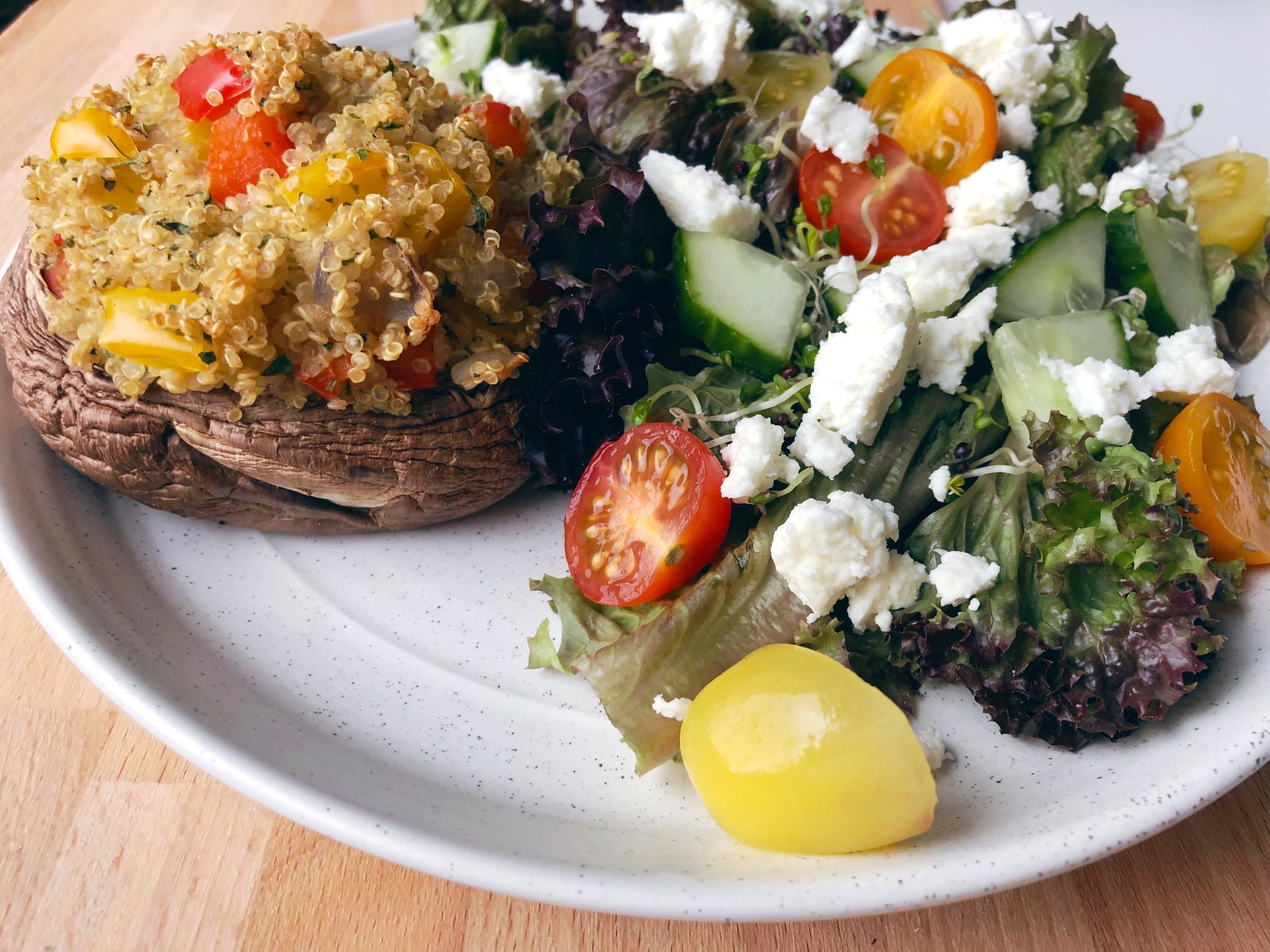by hello@healthfullyheather.com | Mar 20, 2019 | Recipes

Today, when you walk around the produce section of a grocery store, you often have no concept anymore of the four seasons. A wide variety of fruit and vegetables are stocked throughout the year and so we have slowly gotten away from cooking and eating with the seasons.
Spring is just around the corner, and after a long winter you’re probably looking forward to some fresh and bright flavours! Spring and summer bring in some of the most amazing produce, and you might start to feel like moving away from heavier soups and stews towards lighter fare. You might also be preferring raw fruits and veg to cooked. Lean into these cravings and indulge in everything the spring season has to offer!
Eating seasonally also has some other benefits. Choosing in-season produce means you likely are getting fruits and veggies that are more nutrient dense, since they have been grown in their optimal environment and are freshly harvested. They’ll also probably be more flavourful than their off-season neighbours in the produce section!
The best way to do this is to head to your local farmer’s market where you can support local growers and see with your own eyes what has been freshly harvested.
But whether you’re going to the market or just to your local grocery store, I got you! Click below to download my easy guide to spring produce. Pin this up in your kitchen for an easy resource when you’re planning your weekly grocery haul!
See some things on the list you don’t recognize? I challenge you this season to try 2-3 new fruits or veggies! It will help keep meal times interesting, foster creativity in your cooking, and eating a wider range of food usually means a wider range of vitamins and minerals as well!
Let me know what new fruits or veggies you’re going to try in the comments!
Happy shopping!
by hello@healthfullyheather.com | Jan 18, 2019 | Recipes

Today, when you walk around the produce section of a grocery store, you often have no concept anymore of the four seasons. A wide variety of fruit and vegetables are stocked throughout the year and so we have slowly gotten away from cooking and eating with the seasons.
With winter here we often overlook eating seasonally as many of the winter produce is less popular or less known as other seasons. This period is often one of warm, rich foods like baked or roasted veggies, soups, and stews . These warm foods are easier on our digestion as our bodies generally need to use more energy to keep warm or potentially guard against the cold and flu season that may have hit. If you feel this way, then I encourage you to lean into it and fully embrace the change!
Eating seasonally also has some other benefits. Choosing in-season produce means you likely are getting fruits and veggies that are more nutrient dense, since they have been grown in their optimal environment and are freshly harvested. They’ll also probably be more flavourful than their off-season neighbours in the produce section!
The best way to do this is to head to your local farmer’s market where you can support local growers and see with your own eyes what has been freshly harvested.
But whether you’re going to the market or just to your local grocery store, I got you! Click below to download my easy guide to winter produce. Pin this up in your kitchen for an easy resource when you’re planning your weekly grocery haul!
See some things on the list you don’t recognize? I challenge you this season to try 2-3 new fruits or veggies! It will help keep meal times interesting, foster creativity in your cooking, and eating a wider range of food usually means a wider range of vitamins and minerals as well!
Let me know what new fruits or veggies you’re going to try in the comments!
Happy shopping!
by hello@healthfullyheather.com | Oct 12, 2018 | Nutrition 101, Recipes

Today, when you walk around the produce section of a grocery store, you often have no concept anymore of the four seasons. A wide variety of fruit and vegetables are stocked throughout the year and so we have slowly gotten away from cooking and eating with the seasons.
Perhaps thanks to the Pumpkin Spice Latte we do still associate pumpkin and other squashes with the autumn! But there are so many fruits and veggies that belong to this transitional season beyond pumpkin.
With autumn’s arrival the temperatures tend to get cooler and we often move away from raw salads and cold smoothies towards warming foods like roasted veggies and comforting bowls of porridge. These warm foods are easier on our digestion as our bodies generally need to use more energy to keep warm or potentially guard against the cold and flu season that may be beginning to hit. If you feel this way, then I encourage you to lean into it and fully embrace the change!
Eating seasonally also has some other benefits. Choosing in-season produce means you likely are getting fruits and veggies that are more nutrient dense, since they have been grown in their optimal environment and are freshly harvested. They’ll also probably be more flavourful than their off-season neighbours in the produce section!
The best way to do this is to head to your local farmer’s market where you can support local growers and see with your own eyes what has been freshly harvested.
But whether you’re going to the market or just to your local grocery store, I got you! Click below to download my easy guide to autumn produce. Pin this up in your kitchen for an easy resource when you’ll planning your weekly grocery haul!
See some things on the list you don’t recognize? I challenge you this season to try 2-3 new fruits or veggies! It will help keep meal times interesting, foster creativity in your cooking, and eating a wider range of food usually means a wider range of vitamins and minerals as well!
Let me know what new fruits or veggies you’re going to try in the comments!
Happy shopping!
by hello@healthfullyheather.com | Jun 27, 2018 | Recipes

Quinoa is one grain that I always keep in my pantry, but definitely under-utilize in my day-to-day cooking! But it is such a nutritional powerhouse. Did you know that it’s actually not a grain? Quinoa are in fact seeds, but since it can be cooked and ground like other grains it tends to be considered more in the latter category. It’s a good vegetarian source of protein, and contains all the essential amino acids, making it a complete protein.
It’s a very versatile ingredient and can be used in both sweet and savory dishes. This quinoa and bell pepper mixture is one of my favourites, whether it’s stuffed in the Portobello mushroom or as an addition to a meal-sized salad.
Quinoa-stuffed Portobello Mushrooms
-
1/2 cup quinoa
-
1 cup water
-
1 bell pepper, chopped (I used 1/2 each of red and yellow peppers)
-
1 shallot, chopped
-
1 garlic bulb, minced
-
1 tbsp fresh or dried parsley, chopped
-
1 tbsp extra virgin olive oil
-
salt & pepper
-
4 Portobello mushrooms, stems removed
Pre-heat the oven to 350F/175C.
In a pot over medium heat, mix the quinoa and water and bring to a boil. Allow to simmer until water is fully absorbed and quinoa is soft. Add more water if needed.
Meanwhile, in a separate frying pan, sauté the pepper, shallot, and garlic. Season with salt & pepper.
Once quinoa is cooked and pepper, shallot, and garlic is al dente, mix the vegetables in with the quinoa along with the parsley.
With the Portobello mushrooms stem-side up on a lined baking sheet, spoon the quinoa mixture into the mushroom “bowl” packing it down.
Bake in the oven for 20 minutes, the mushrooms should become soft but still hold their shape.
Serve as you desire, perhaps with a sprinkle on top of fresh parsley and some feta!
Serves 4





